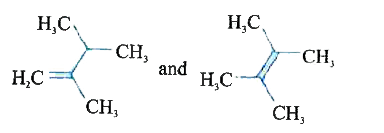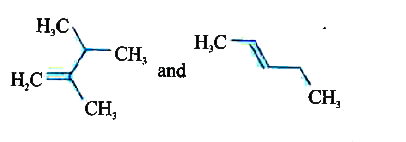An alkyl halide of formula C4H9Cl on treatement with alcoholic potash gives alkenes C4H8. Both alkenes on tratment with HI gives 2-iodo butate. Isomeric alkenes are
CH3CH2CH=CH2andCH3CH=CHCH3
CH3CH2=CH2and(CH3)2C=CH2
CH3CH=CH2andCH3CH=CHCH3
CH3CH2CH=CH2andCH3CH=CH2
The correct Answer is:A
Because rate of reaction depends upon concentration of anly 3∘ alkyl halide not on concentration of aq. Potash.
(a) Molecular formula C4H9Cl has four isomers, thses are n-butyl chloride,sec. butyl chloride. Former two on elimination gives 1-butene and 2-butene respectively and latter two on elimination gives siobutylene. 1-butene and 2-butene are treated withHI gives 2-iodobutane. 1-butene and 2-butene are position isomers. Isobutylene is treated with HI gives t-butyl iodide hence answer is (a)
Topper's Solved these Questions
- BOOK - NIKITA PUBLICATIONCHAPTER - GENERAL PRINCIPLES & PROCESSES OF ISOLATION OF ELEMENTSEXERCISE - Multiple choice questions117videos
GENERAL PRINCIPLES & PROCESSES OF ISOLATION OF ELEMENTS
- BOOK - NIKITA PUBLICATIONCHAPTER - MCQs FROM PREVIOUS BOARD QUESTION PAPERS EXERCISE - Question Paper- MHT-CET 201850videos
MCQs FROM PREVIOUS BOARD QUESTION PAPERS
Similar Questions
An alkyl halide (A) of formula C6H11Cl on treatement with potassium tertiary butoxie gives two isomeric alkenes (B) and (C) C6H10. Both alkene on hydrogenation give methycyclopentane. Predict the structure of (A), (B) and (C).
View SolutionAn alkyl halide (A) of formula C6H11Cl on treatment with potassium tertiary butoxide gives two isomeric alkenes (B) and (C) C6H10. Both alkene on hydrogenation give methylcyclopentane. Predict the structure of (A), (B) and (C).
View Solution
Knowledge Check
- Question 1 - Select One
An alkyl halide of formula C4H9Cl on treatment with alcoholic potash gives alkenes C4H8. Both alkenes on treatment with HI give 2-iodobutane. Isomeric alkenes are
ACH3CH2CH=CH2andCH3CH=CHCH3BCH3CH2CH=CH2and(CH3)2C=CH2CCH3CH=CH2andCH3CH=CHCH3DCH3CH2CH=CH2andCH3CH=CH2 - Question 2 - Select One
An alkyl halide of formula C6CH13Cl on treatment with potassium t-butoxide gives two isomeric alkenes (C6H12). Both alkenes on hydrogenation give 2,2-dimethylbutane. Isomeric alkenes are
ACH2=C∣CH3−C∣CH3H−CH3andCH3−C∣CH2=C∣CH3−CH3BCH2=C∣CH3−C∣CH3H−CH3andCH3−CH=CH−CH2CH3CCH3−CH=CH−CH2CH3and(CH3)2C=(CH3)2DCH2=C∣CH3−C∣CH3H−CH3andCH2=C∣CH3−CH2−CH2−CH3 - Question 3 - Select One
An alkyl halide of formula C6H13CI on treatment with potassium t-butoxide given two isomeric alkanes (C6H12) . Both alkenes on hydrogenation give 2,3 dimethyl butane. Isomeric alkanes are
A B
B C
C D
D
An alkyl halide (X)of the folmula C6H13Cl on treatment with potassium tertiary butoxide gives two isomeric alkenes (Y) and (Z)(C6H12). Both the alkenes on hydrogenation give 2,3−dimethyl butane. Perdict the structures of (X),(Y) , and (Z)
View SolutionAn alkyl halide (X)of the folmula C6H13Cl on treatment with potassium tertiary butoxide gives two isomeric alkenes (Y) and (Z)(C6H12). Both the alkenes on hydrogenation give 2,3−dimethyl butane. Perdict the structures of (X),(Y) , and (Z)
View SolutionAn alkyl halide (X)of the folmula C6H13Cl on treatment with potassium tertiary butoxide gives two isomeric alkenes (Y) and (Z)(C6H12). Both the alkenes on hydrogenation give 2,3−dimethyl butane. Perdict the structures of (X),(Y) , and (Z)
View SolutionAn alkyl halide (X)of the folmula C6H13Cl on treatment with potassium tertiary butoxide gives two isomeric alkenes (Y) and (Z)(C6H12). Both the alkenes on hydrogenation give 2,3−dimethyl butane. Perdict the structures of (X),(Y) , and (Z)
View SolutionAn alkyl halide of formula C6H13Br on treatment with potassium t-butoxide gives two isomeric alkenes dimethy butane. Isomeric alkene are :
View Solution

